Evaluation of the Coupling Coordination Degree Between PM2.5 and Urbanization Level: A Case in Guangdong Province
Abstract
1. Introduction
2. Materials and Methods
2.1. Data Sources
2.1.1. Fine Particulate Matter
2.1.2. Night Lights
2.1.3. MOD13A1 NDVI
2.1.4. Land Cover Type
2.1.5. Population Distribution
2.1.6. Road Maps
2.1.7. Socioeconomic Statistics
2.2. Research Methodology
2.2.1. Construction of Comprehensive Evaluation Indicators for Urbanization
2.2.2. PM2.5 Spatiotemporal Pattern Analysis
2.2.3. Coupled Coordination Degree Model
3. Results and Discussion
3.1. Detection of PM2.5 Concentration Change in Guangdong Province
3.2. Relationship Between PM2.5 and Urbanization Characteristics
3.2.1. Trend Mutation Detection
3.2.2. Relationship Between Key Urbanization Factors and PM2.5 Concentrations
3.2.3. EKC Relationship Validation
3.3. Evaluation of the Coupling Coordination Degree Between PM2.5 and Urbanization Level
4. Conclusions
Supplementary Materials
Author Contributions
Funding
Institutional Review Board Statement
Informed Consent Statement
Data Availability Statement
Conflicts of Interest
References
- National Bureau of Statistics of China. Communiqué of the Seventh National Population Census (No. 5); National Bureau of Statistics of China: Beijing, China, 2021. [Google Scholar]
- National Bureau of Statistics of China. Wang Pingping: The Decline in the Total Population Has Narrowed, and the Quality of the Population Continues to Improve; National Bureau of Statistics of China: Beijing, China, 2025. [Google Scholar]
- Khor, N.J.K. World Cities Report 2022: Envisaging the Future of Cities; United Nations Human Settlements Programme (UN-Habitat): Nairobi, Kenya, 2022. [Google Scholar]
- Yan, G.; Zhang, P.; Yang, J.; Zhang, J.; Zhu, G.; Cao, Z.; Fan, J.; Liu, Z.; Wang, Y. Chemical characteristics and source apportionment of PM2.5 in a petrochemical city: Implications for primary and secondary carbonaceous component. J. Environ. Sci. 2021, 103, 322–335. [Google Scholar] [CrossRef] [PubMed]
- Pei, L.; Yan, Z.; Chen, D.; Miao, S. Climate variability or anthropogenic emissions: Which caused Beijing Haze? Environ. Res. Lett. 2020, 15, 034004. [Google Scholar] [CrossRef]
- Zhang, J.; Huang, X.; Li, J.; Chen, L.; Zhao, R.; Wang, R.; Sun, W.; Chen, C.; Su, Y.; Wang, F. Chemical composition, sources and evolution of PM2.5 during wintertime in the city cluster of southern Sichuan, China. Atmos. Pollut. Res. 2023, 14, 101635. [Google Scholar] [CrossRef]
- Yue, H.B.; He, C.Y.; Huang, Q.X.; Yin, D.; Bryan, B.A. Stronger policy required to substantially reduce deaths from PM pollution in China. Nat. Commun. 2020, 11, 1462. [Google Scholar] [CrossRef] [PubMed]
- Meng, J.C.; Han, W.C.; Yuan, C.; Yuan, L.L.; Li, W.Z. The capacity of human interventions to regulate PM2.5 concentration has substantially improved in China. Environ. Int. 2025, 195, 109251. [Google Scholar] [CrossRef] [PubMed]
- Ministry of Ecology and Environment of People’s Republic of China. The Ministry of Ecology and Environment Held a Regular Press Conference in February; Ministry of Ecology and Environment of People’s Republic of China: Beijing, China, 2021. [Google Scholar]
- State Council of the People’s Republic of China. Notice of the State Council on Issuing the Action Plan for Continuous Improvement of Air Quality; State Council of the People’s Republic of China: Beijing, China, 2023. [Google Scholar]
- Lv, T.; Wang, L.; Zhang, X.; Xie, H.; Lu, H.; Li, H.; Liu, W.; Zhang, Y. Coupling coordinated development and exploring its influencing factors in Nanchang, China: From the perspectives of land urbanization and population urbanization. Land 2019, 8, 178. [Google Scholar] [CrossRef]
- Chen, L.; Li, K.; Chen, S.; Wang, X.; Tang, L. Industrial activity, energy structure, and environmental pollution in China. Energy Econ. 2021, 104, 105633. [Google Scholar] [CrossRef]
- Wang, X.; Dong, F.; Pan, Y.; Liu, Y. Transport infrastructure, high-quality development and industrial pollution: Fresh evidence from China. Int. J. Environ. Res. Public Health 2022, 19, 9494. [Google Scholar] [CrossRef] [PubMed]
- Zhang, X.; Han, L.; Wei, H.; Tan, X.; Zhou, W.; Li, W.; Qian, Y. Linking urbanization and air quality together: A review and a perspective on the future sustainable urban development. J. Clean. Prod. 2022, 346, 130988. [Google Scholar] [CrossRef]
- Chen, X.; Gu, X.; Liu, P.; Wang, D.; Mumtaz, F.; Shi, S.; Liu, Q.; Zhan, Y. Impacts of inter-annual cropland changes on land surface temperature based on multi-temporal thermal infrared images. Infrared Phys. Technol. 2022, 122, 104081. [Google Scholar] [CrossRef]
- Ahmed, Z.; Asghar, M.M.; Malik, M.N.; Nawaz, K. Moving towards a sustainable environment: The dynamic linkage between natural resources, human capital, urbanization, economic growth, and ecological footprint in China. Resour. Policy 2020, 67, 101677. [Google Scholar] [CrossRef]
- Yi, Z.; Cao, X.; Qin, L. Evaluation of Socially and Culturally Coordinated Development in Cities of Yangtze River Economic Belt and Its Spatial Correlation. Land 2025, 14, 1226. [Google Scholar] [CrossRef]
- Cha, J.P.; Li, F.F.; Zheng, S.F.; Deng, Y.S. Assessment of county level urbanization with the consideration of coupling coordination among population-economy-space-society-green in the Lower Yellow River basin of China. Environ. Dev. Sustain. 2024. [Google Scholar] [CrossRef]
- Yang, C.; Zeng, W.; Yang, X. Coupling coordination evaluation and sustainable development pattern of geo-ecological environment and urbanization in Chongqing municipality, China. Sustain. Cities Soc. 2020, 61, 102271. [Google Scholar] [CrossRef]
- Feng, H.; Fu, J.; Li, H.; Liang, Y. Urbanization or “Townization”? Measuring the evolution of Urban Systems in modern China. China Econ. Rev. 2025, 90, 102368. [Google Scholar] [CrossRef]
- Shan, L.; Jiang, Y.H.; Liu, C.C.; Wang, Y.F.; Zhang, G.H.; Cui, X.F.; Li, F. Exploring the multi-dimensional coordination relationship between population urbanization and land urbanization based on the MDCE model: A case study of the Yangtze River Economic Belt, China. PLoS ONE 2021, 16, e0253898. [Google Scholar] [CrossRef] [PubMed]
- Zheng, Y.M.; Zhou, Q.; He, Y.R.; Wang, C.P.; Wang, X.R.; Wang, H.W. An Optimized Approach for Extracting Urban Land Based on Log-Transformed DMSP-OLS Nighttime Light, NDVI, and NDWI. Remote Sens. 2021, 13, 766. [Google Scholar] [CrossRef]
- Huang, S.; Yu, L.; Cai, D.; Zhu, J.; Liu, Z.; Zhang, Z.; Nie, Y.; Fraedrich, K. Driving mechanisms of urbanization: Evidence from geographical, climatic, social-economic and nighttime light data. Ecol. Indic. 2023, 148, 110046. [Google Scholar] [CrossRef]
- Chen, Z.; Yu, S.; You, X.; Yang, C.; Wang, C.; Lin, J.; Wu, W.; Yu, B. New nighttime light landscape metrics for analyzing urban-rural differentiation in economic development at township: A case study of Fujian province, China. Appl. Geogr. 2023, 150, 102841. [Google Scholar] [CrossRef]
- Li, F.; Liu, X.Y.; Liao, S.B.; Jia, P. The Modified Normalized Urban Area Composite Index: A Satelliate-Derived High-Resolution Index for Extracting Urban Areas. Remote Sens. 2021, 13, 2350. [Google Scholar] [CrossRef]
- Wang, Y.; Liu, Z.; He, C.; Xia, P.; Liu, Z.; Liu, H. Quantifying urbanization levels on the Tibetan Plateau with high-resolution nighttime light data. Geogr. Sustain. 2020, 1, 233–244. [Google Scholar] [CrossRef]
- Wang, J.; Liu, H.; Liu, H.; Huang, H. Spatiotemporal evolution of multiscale urbanization level in the Beijing-Tianjin-Hebei Region using the integration of DMSP/OLS and NPP/VIIRS night light datasets. Sustainability 2021, 13, 2000. [Google Scholar] [CrossRef]
- Arshad, K.; Hussain, N.; Ashraf, M.H.; Saleem, M.Z. Air pollution and climate change as grand challenges to sustainability. Sci. Total Environ. 2024, 928, 172370. [Google Scholar]
- Kosovac, A.; Pejic, D. Cities and the SDGs: A spotlight on urban settlements. In The Environment in Global Sustainability Governance; Bristol University Press: Bristol, UK, 2023; pp. 269–294. [Google Scholar]
- Sahoo, M.; Sethi, N. The dynamic impact of urbanization, structural transformation, and technological innovation on ecological footprint and PM2.5: Evidence from newly industrialized countries. Environ. Dev. Sustain. 2022, 24, 4244–4277. [Google Scholar] [CrossRef]
- Cui, L.; Weng, S.; Nadeem, A.M.; Rafique, M.Z.; Shahzad, U. Exploring the role of renewable energy, urbanization and structural change for environmental sustainability: Comparative analysis for practical implications. Renew. Energy 2022, 184, 215–224. [Google Scholar] [CrossRef]
- Hao, Y.; Zheng, S.; Zhao, M.; Wu, H.; Guo, Y.; Li, Y. Reexamining the relationships among urbanization, industrial structure, and environmental pollution in China—New evidence using the dynamic threshold panel model. Energy Rep. 2020, 6, 28–39. [Google Scholar] [CrossRef]
- Munsif, R.; Zubair, M.; Aziz, A.; Zafar, M.N. Industrial air emission pollution: Potential sources and sustainable mitigation. In Environmental Emissions; IntechOpen: London, UK, 2021. [Google Scholar]
- Saxena, V. Water Quality, Air Pollution, and Climate Change: Investigating the Environmental Impacts of Industrialization and Urbanization. Water Air Soil Pollut. 2025, 236, 73. [Google Scholar] [CrossRef]
- Padhiary, M.; Kumar, R. Assessing the environmental impacts of agriculture, industrial operations, and mining on agro-ecosystems. In Smart Internet of Things for Environment and Healthcare; Springer: Berlin/Heidelberg, Germany, 2024; pp. 107–126. [Google Scholar]
- Shi, K.; Wu, Y.; Li, L. Quantifying and evaluating the effect of urban expansion on the fine particulate matter (PM2.5) emissions from fossil fuel combustion in China. Ecol. Indic. 2021, 125, 107541. [Google Scholar] [CrossRef]
- Ul-Haq, Z.; Mehmood, U.; Tariq, S.; Mariam, A. Defining the role of renewable energy, economic growth, globalization, energy consumption, and population growth on PM2.5 concentration: Evidence from South Asian countries. Environ. Sci. Pollut. Res. 2023, 30, 40008–40017. [Google Scholar] [CrossRef] [PubMed]
- Huang, C.; Liu, K.; Zhou, L. Spatio-temporal trends and influencing factors of PM2.5 concentrations in urban agglomerations in China between 2000 and 2016. Environ. Sci. Pollut. Res. 2021, 28, 10988–11000. [Google Scholar] [CrossRef] [PubMed]
- Fu, Z.; Li, R. The contributions of socioeconomic indicators to global PM2.5 based on the hybrid method of spatial econometric model and geographical and temporal weighted regression. Sci. Total Environ. 2020, 703, 135481. [Google Scholar] [CrossRef] [PubMed]
- Deng, Y.; Yang, R. Influence mechanism of production-living-ecological space changes in the urbanization process of Guangdong Province, China. Land 2021, 10, 1357. [Google Scholar] [CrossRef]
- Zeng, F.; Ren, C.; Wang, W.; Zhou, L.; Dai, X.; Ma, W. Exploring PM2.5 and O3 disparities and synergies management through integrated natural and sociology-environmental drivers in the YRD. Air Qual. Atmos. Health 2025, 1–20. [Google Scholar] [CrossRef]
- Wei, J.; Li, Z.Q.; Lyapustin, A.; Sun, L.; Peng, Y.R.; Xue, W.H.; Su, T.N.; Cribb, M. Reconstructing 1-km-resolution high-quality PM data records from 2000 to 2018 in China: Spatiotemporal variations and policy implications. Remote Sens. Environ. 2021, 252, 112136. [Google Scholar] [CrossRef]
- Li, X.; Song, Y.; Liu, H.; Hou, X. Extraction of Urban Built-Up Areas Using Nighttime Light (NTL) and Multi-Source Data: A Case Study in Dalian City, China. Land 2023, 12, 495. [Google Scholar] [CrossRef]
- Huang, X.; Yang, J. The 30 m annual land cover datasets and its dynamics in China from 1985 to 2022. Earth Syst. Sci. Data 2023, 13, 3907–3925. [Google Scholar]
- Ran, H.F.; Zhang, F.; Chan, N.W.; Tan, M.L.; Kung, H.T.; Shi, J.C. New Composite Nighttime Light Index (NCNTL): A New Index for Urbanization Evaluation Research. IEEE J. Sel. Top. Appl. Earth Obs. Remote Sens. 2023, 16, 3418–3434. [Google Scholar] [CrossRef]
- Tang, P.; Huang, J.; Zhou, H.; Wang, H.; Huang, W.; Huang, X.; Yuan, Y. The spatiotemporal evolution of urbanization of the countries along the Belt and Road Initiative using the compounded night light index. Arab. J. Geosci. 2021, 14, 1677. [Google Scholar] [CrossRef]
- Zheng, Y.; Tang, L.; Wang, H. An improved approach for monitoring urban built-up areas by combining NPP-VIIRS nighttime light, NDVI, NDWI, and NDBI. J. Clean. Prod. 2021, 328, 129488. [Google Scholar] [CrossRef]
- Andries, A.; Morse, S.; Murphy, R.J.; Sadhukhan, J.; Martinez-Hernandez, E.; Amezcua-Allieri, M.A.; Aburto, J. Potential of using night-time light to proxy social indicators for sustainable development. Remote Sens. 2023, 15, 1209. [Google Scholar] [CrossRef]
- Qiao, Z.; Xu, X.; Wang, X.; Zhang, Y. Comprehensive Evaluation of Urban Renewal Based on Entropy and TOPSIS Method: A Case of Shandong Province. J. Contemp. Urban Aff. 2025, 9, 1–15. [Google Scholar] [CrossRef]
- Aswad, F.K.; Yousif, A.A.; Ibrahim, S.A. Trend analysis using Mann-Kendall and Sen’s slope estimator test for annual and monthly rainfall for Sinjar district, Iraq. J. Duhok Univ. 2020, 23, 501–508. [Google Scholar] [CrossRef]
- Agarwal, S.; Suchithra, A.; Singh, S.P. Analysis and interpretation of rainfall trend using Mann-Kendall’s and Sen’s slope method. Indian J. Ecol. 2021, 48, 453–457. [Google Scholar]
- Garba, H.; Udokpoh, U.U. Analysis of trend in meteorological and hydrological time-series using Mann-Kendall and Sen’s slope estimator statistical test in Akwa Ibom state, Nigeria. Int. J. Environ. Clim. Change 2023, 13, 1017–1035. [Google Scholar] [CrossRef]
- Liu, X. Effects of Urban Density and City Size on Haze Pollution in China: Spatial Regression Analysis Based on 253 Prefecture-Level Cities PM2.5 Data. Discret. Dyn. Nat. Soc. 2019, 2019, 6754704. [Google Scholar] [CrossRef]
- Chen, Y. Spatial autocorrelation equation based on Moran’s index. Sci. Rep. 2023, 13, 19296. [Google Scholar] [CrossRef] [PubMed]
- Wang, Y.; Lv, W.; Wang, M.; Chen, X.; Li, Y. Application of improved Moran’s I in the evaluation of urban spatial development. Spat. Stat. 2023, 54, 100736. [Google Scholar] [CrossRef]
- Chen, Y. An analytical process of spatial autocorrelation functions based on Moran’s index. PLoS ONE 2021, 16, e0249589. [Google Scholar] [CrossRef] [PubMed]
- Conte, L.C.; Bayer, D.M.; Bayer, F.M. Bootstrap Pettitt test for detecting change points in hydroclimatological data: Case study of Itaipu Hydroelectric Plant, Brazil. Hydrol. Sci. J. 2019, 64, 1312–1326. [Google Scholar] [CrossRef]
- Hu, Y.; Yang, C.; Liang, Z.; Luo, X.; Huang, Y.; Tang, C. A Non-Parametric Approach for Change-Point Detection of Multi-Parameters in Time-Series Data. J. Environ. Inform. 2023, 42, 65–74. [Google Scholar] [CrossRef]
- Militino, A.F.; Moradi, M.; Ugarte, M.D. On the performances of trend and change-point detection methods for remote sensing data. Remote Sens. 2020, 12, 1008. [Google Scholar] [CrossRef]
- Magazzino, C.; Gallegati, M.; Giri, F. The Environmental Kuznets Curve in a long-term perspective: Parametric vs semi-parametric models. Environ. Impact Assess. Rev. 2023, 98, 106973. [Google Scholar] [CrossRef]
- Şentürk, H.; Omay, T.; Yildirim, J.; Köse, N. Environmental Kuznets curve: Non-linear panel regression analysis. Environ. Model. Assess. 2020, 25, 633–651. [Google Scholar] [CrossRef]
- Isik, C.; Ongan, S.; Ozdemir, D.; Ahmad, M.; Irfan, M.; Alvarado, R.; Ongan, A. The increases and decreases of the environment Kuznets curve (EKC) for 8 OECD countries. Environ. Sci. Pollut. Res. 2021, 28, 28535–28543. [Google Scholar] [CrossRef] [PubMed]
- Cheikh, N.B.; Zaied, Y.B.; Chevallier, J. On the nonlinear relationship between energy use and CO2 emissions within an EKC framework: Evidence from panel smooth transition regression in the MENA region. Res. Int. Bus. Financ. 2021, 55, 101331. [Google Scholar] [CrossRef]
- Mahmood, H.; Furqan, M.; Hassan, M.S.; Rej, S. The environmental Kuznets Curve (EKC) hypothesis in China: A review. Sustainability 2023, 15, 6110. [Google Scholar] [CrossRef]
- Li, X.; Lu, Z.; Hou, Y.; Zhao, G.; Zhang, L. The coupling coordination degree between urbanization and air environment in the Beijing (Jing)-Tianjin (Jin)-Hebei (Ji) urban agglomeration. Ecol. Indic. 2022, 137, 108787. [Google Scholar] [CrossRef]
- GB 3095-2012; Ambient Air Quality Standards. Ministry of Ecology and Environment of the People’s Republic of China: Beijing, China, 2016.
- Liu, Z.; Fang, C.; Sun, B.; Liao, X. Governance matters: Urban expansion, environmental regulation, and PM2.5 pollution. Sci. Total Environ. 2023, 876, 162788. [Google Scholar] [CrossRef] [PubMed]
- Website, C.d. The Ministry of Environmental Protection Defines “Haze Pollution Day”. 2014. Available online: https://np.china-embassy.gov.cn/eng/News/201405/t20140515_1584207.htm (accessed on 25 March 2025).
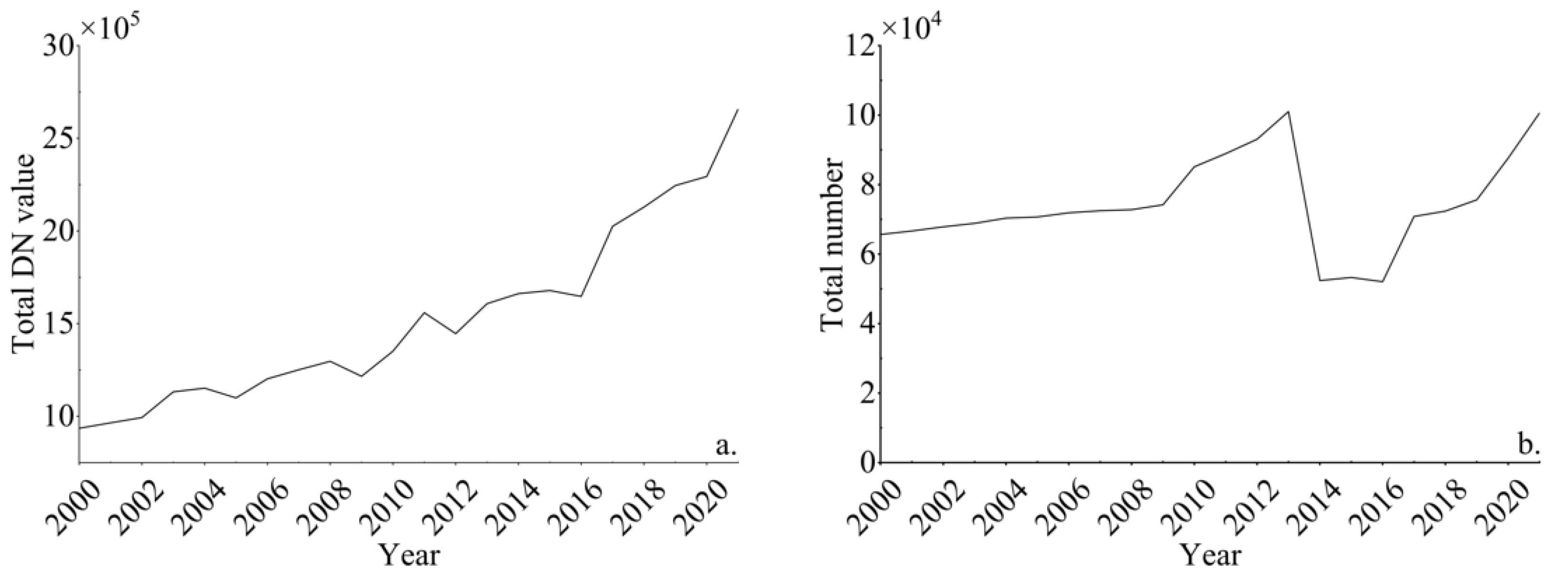


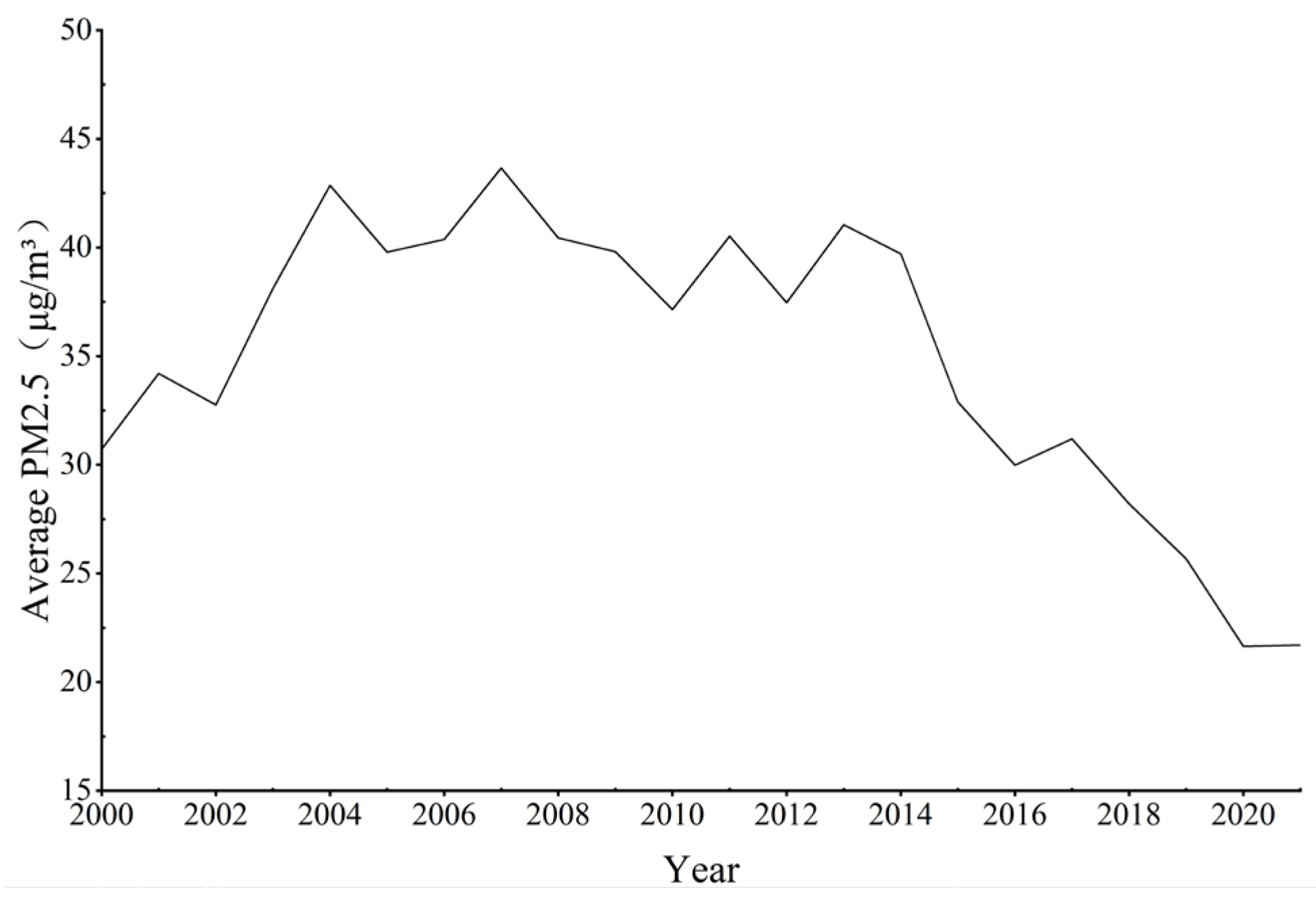
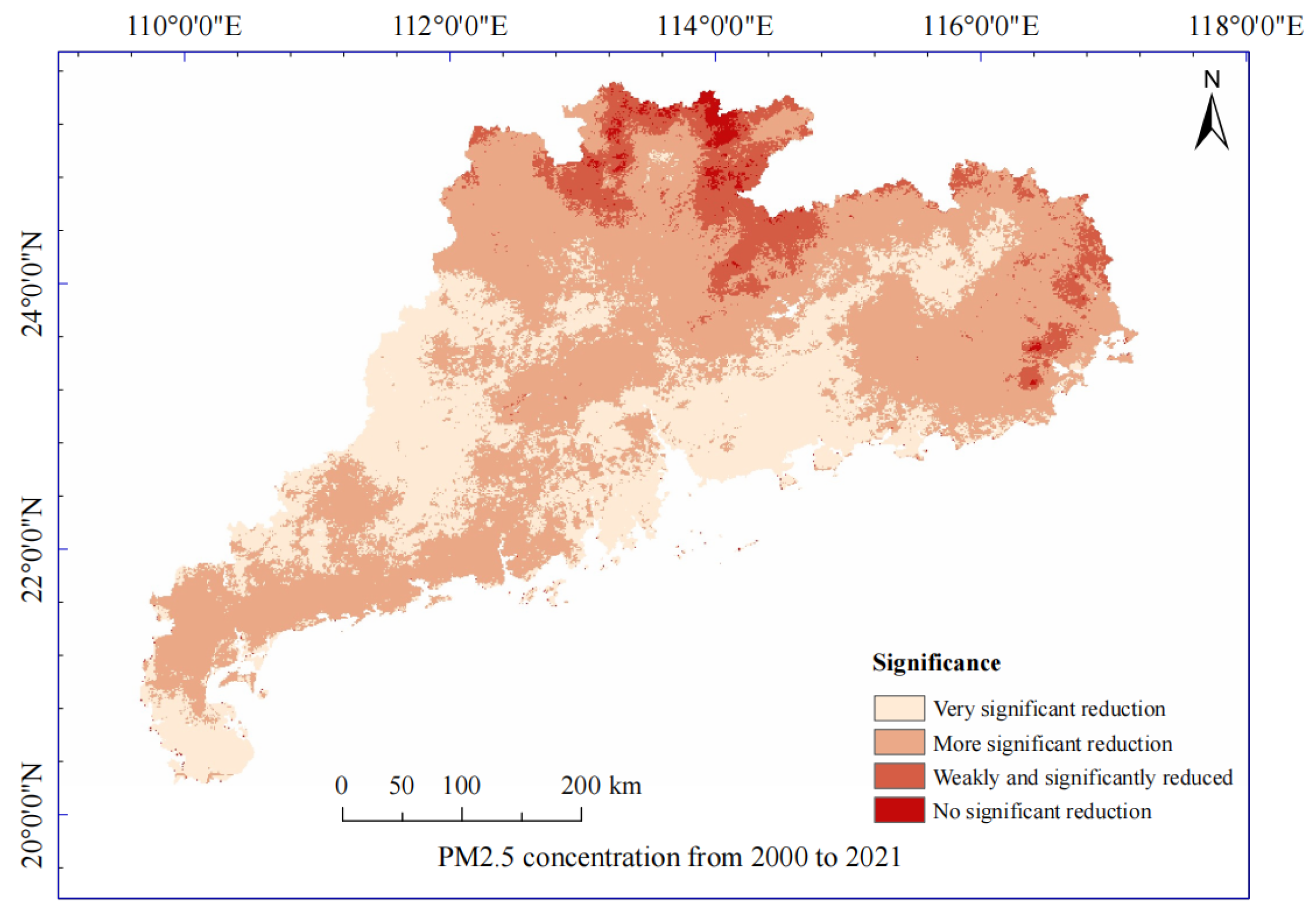

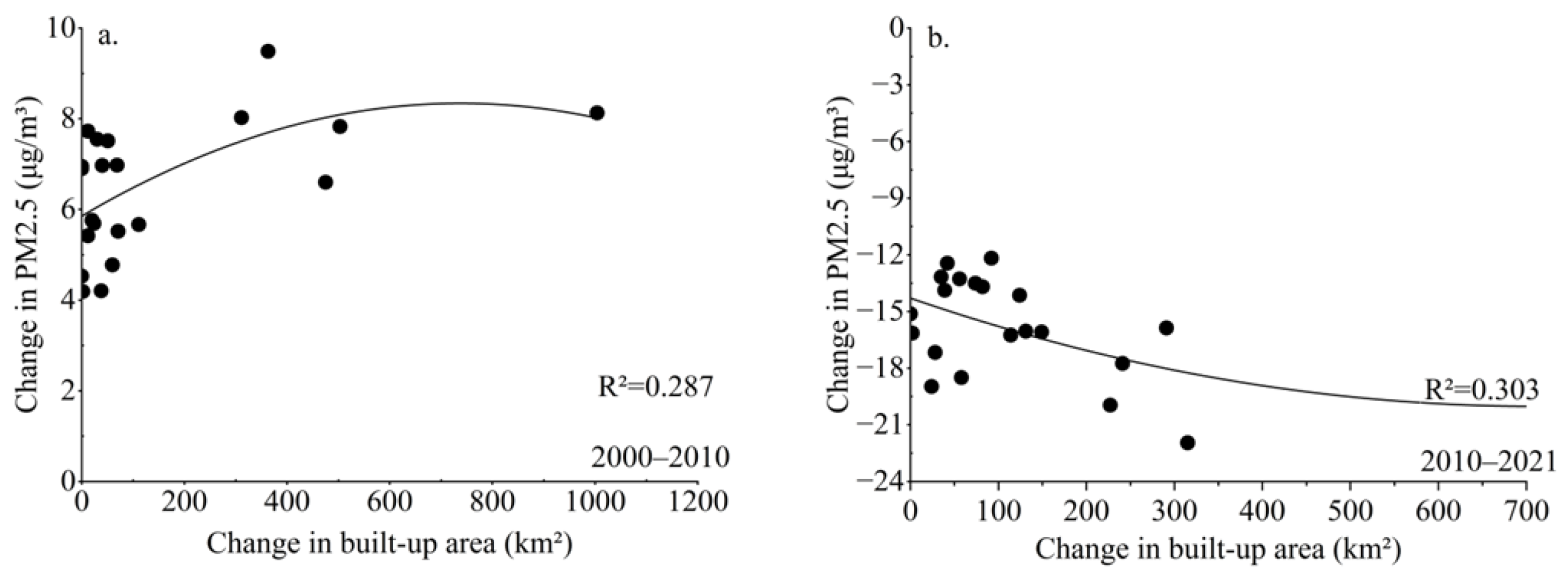

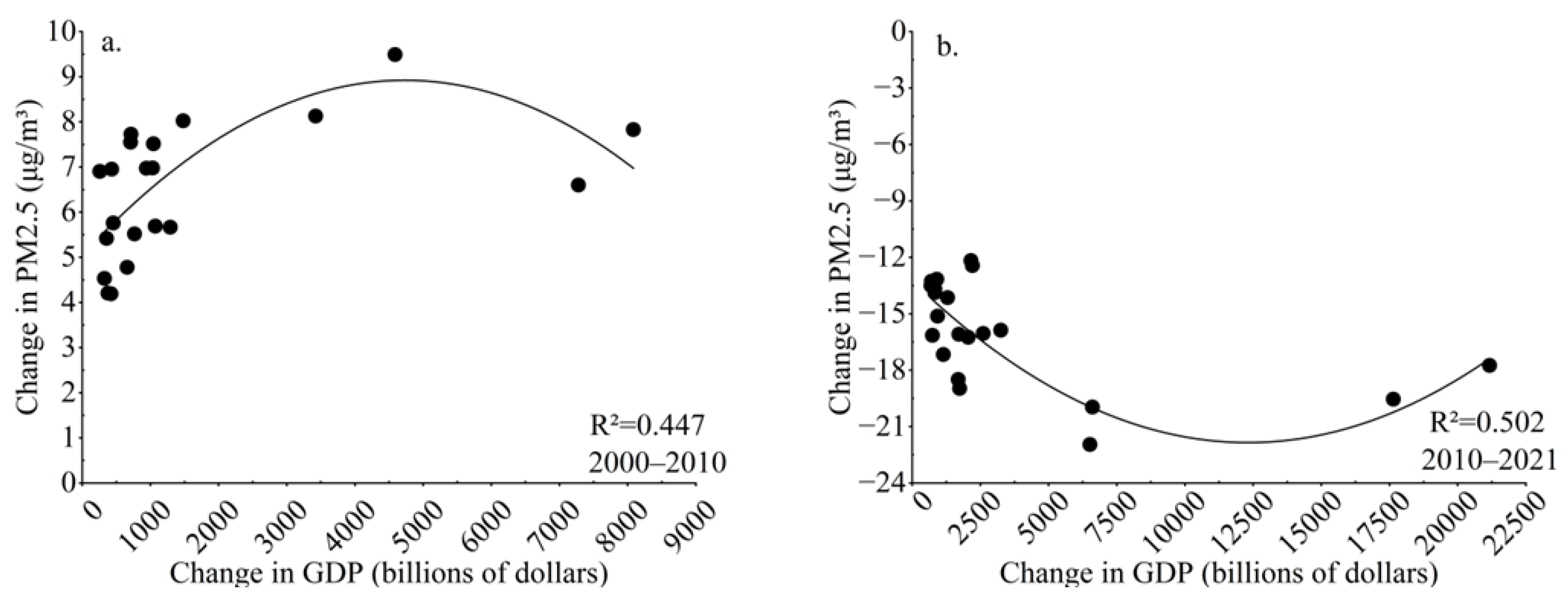

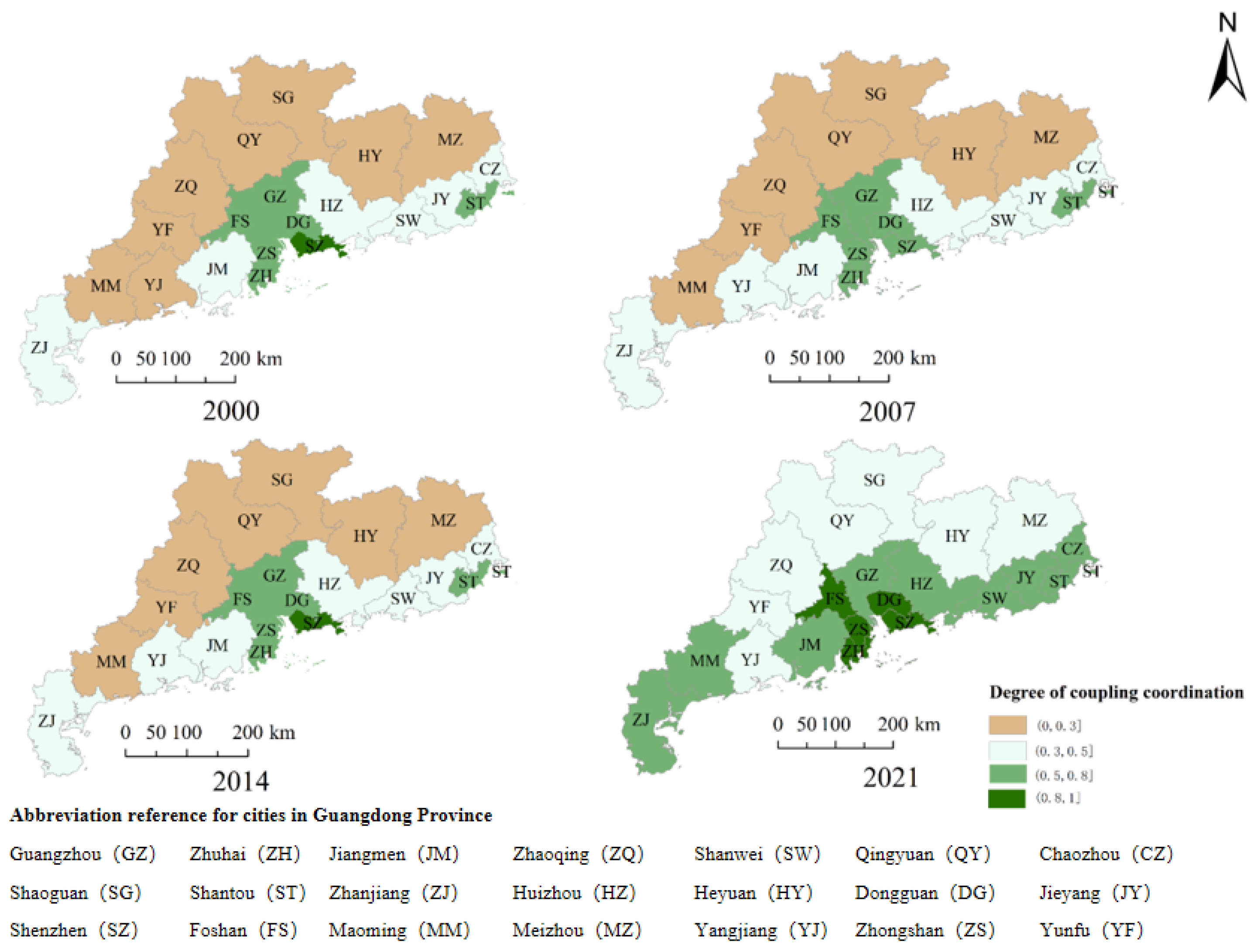
| Year | Statistical Value/km2 | Extracted Value/km2 | Inaccuracies |
|---|---|---|---|
| 2000 | 1764 | 1598 | 9.41% |
| 2010 | 4618 | 4798 | 3.90% |
| 2021 | 6583 | 7087 | 7.66% |
| Method | Use |
|---|---|
| Composite nighttime light intensity index [45,46,47,48] | Extracting urban built-up areas to reveal differences in urbanization levels |
| Entropy (physics) [49] | Quantifying the multifactor contribution to the urbanization level score |
| Sen slope estimation and Mann–Kendall nonparametric test uses [50,51,52] | Detecting PM2.5 trends |
| Moran’s I Index [53,54,55,56] | Reflecting spatial correlations and differences in PM2.5 status |
| Pettitt change point detection [57,58,59] | Detecting sudden changes in light intensity at night |
| EKC panel regression model [60,61,62,63] | Describing the relevance of the economy to the environment and its patterns of change |
| Year | 2000 | 2007 | 2014 | 2021 |
|---|---|---|---|---|
| Moran’s I | 0.7 | 0.77 | 0.8 | 0.703 |
| Z | All greater than 2.58 | |||
| P | 0.01 level, significant correlation | |||
| Key Constituent | ||||
|---|---|---|---|---|
| Built-up area | 1.7 × 10−2 | −2.3 × 10−6 | 10.721 | 0.902 |
| Size of population | 6.63 × 10−6 | −3.244 × 10−14 | −297.503 | 0.862 |
| GDP | 2.87 × 10−4 | −3.2969 × 10−9 | 33.301 | 0.799 |
| Type | D | Subcategory | Subtype | State |
|---|---|---|---|---|
| Discordance period | (0,0.3] | Severe discordance | g(E) − f(U) > 0.1 | Severe developmental imbalance, urbanization process obstruction |
| f(U) − g(E) > 0.1 | Severe developmental imbalance, atmospheric environment deterioration | |||
| 0 ≤ |f(U) − g(E)| ≤ 0.1 | Severe imbalance between urbanization and atmospheric environment development | |||
| (0.3,0.5] | Elementary discordance | g(E) − f(U) > 0.1 | Slightly imbalanced development with constrained urbanization progress | |
| f(U) − g(E) > 0.1 | Mild developmental imbalance with deteriorated air environment | |||
| 0 ≤ |f(U) − g(E)| ≤ 0.1 | Slight imbalance between urbanization and air environment development | |||
| Transitional phase | (0.5,0.8] | Primary coordination | g(E) − f(U) > 0.1 | Marginally balanced development with lagging urbanization |
| f(U) − g(E) > 0.1 | Marginally balanced development with lagging air environment | |||
| 0 ≤ |f(U) − g(E)| ≤ 0.1 | Marginally balanced development between urbanization and air environment | |||
| Primary coordination | (0.8,1] | Advanced coordination | g(E) − f(U) > 0.1 | Highly balanced development with lagging urbanization |
| f(U) − g(E) > 0.1 | Hyper-balanced development with lagging air environment | |||
| 0 ≤ |f(U) − g(E)| ≤ 0.1 | Exceptional balanced development between urbanization and air environment |
| Year | 2000 | 2007 | 2014 | 2021 | |
|---|---|---|---|---|---|
| City | |||||
| Guangzhou | Primary Coordination—Urbanization Lag | Primary Balanced Coordination | Primary Coordination—Urbanization Lag | ||
| Shaoguan | Severe Discordance—Urbanization Lag | Elementary Discordance—Urbanization Lag | |||
| Shenzhen | Primary Coordination—Air Quality Lag | Advanced Coordination—Air Quality Lag | |||
| Zhuhai | Primary Coordination—Urbanization Lag | Primary Balanced Coordination | Advanced Balanced Coordination | ||
| Shantou | Primary Balanced Coordination | Primary Coordination—Air Quality Lag | |||
| Foshan | Primary Coordination—Urbanization Lag | Primary Coordination—Air Quality Lag | Advanced Balanced Coordination | ||
| Jiangmen | Elementary Discordance—Urbanization Lag | Primary Coordination—Urbanization Lag | |||
| Zhanjiang | |||||
| Maoming | Severe Discordance—Urbanization Lag | ||||
| Zhaoqing | Elementary Discordance—Urbanization Lag | ||||
| Meizhou | |||||
| Huizhou | Elementary Discordance—Urbanization Lag | Primary Coordination—Urbanization Lag | |||
| Shanwei | |||||
| Heyuan | Severe Discordance—Urbanization Lag | Elementary Discordance—Urbanization Lag | |||
| Yangjiang | Severe Discordance—Urbanization Lag | Elementary Discordance—Urbanization Lag | |||
| Qingyuan | Severe Discordance—Urbanization Lag | ||||
| Dongguan | Primary Coordination—Air Quality Lag | Primary Coordination—Air Quality Lag | Advanced Coordination—Air Quality Lag | ||
| Zhongshan | Primary Coordination—Urbanization Lag | ||||
| Chaozhou | Elementary Discordance—Urbanization Lag | Primary Coordination—Urbanization Lag | |||
| Jieyang | |||||
| Yunfu | Severe Discordance—Urbanization Lag | Elementary Discordance—Urbanization Lag | |||
| Legend for Table Colors | |||||
| Severe Discordance | Severe Discordance—Urbanization Lag | ||||
| Elementary Discordance | Elementary Discordance—Urbanization Lag | ||||
| Primary Coordination | Primary Balanced Coordination | ||||
| Primary Coordination—Urbanization Lag | |||||
| Primary Coordination—Air Quality Lag | |||||
| Advanced Coordination | Advanced Balanced Coordination | ||||
| Advanced Coordination—Air Quality Lag | |||||
Disclaimer/Publisher’s Note: The statements, opinions and data contained in all publications are solely those of the individual author(s) and contributor(s) and not of MDPI and/or the editor(s). MDPI and/or the editor(s) disclaim responsibility for any injury to people or property resulting from any ideas, methods, instructions or products referred to in the content. |
© 2025 by the authors. Licensee MDPI, Basel, Switzerland. This article is an open access article distributed under the terms and conditions of the Creative Commons Attribution (CC BY) license (https://creativecommons.org/licenses/by/4.0/).
Share and Cite
Shen, J.; Zhu, Z.; Wang, D.; Yang, Y.; Mo, Y.; Xia, H.; Yang, X.; Wang, Y.; Li, Z.; Wang, J. Evaluation of the Coupling Coordination Degree Between PM2.5 and Urbanization Level: A Case in Guangdong Province. Sustainability 2025, 17, 6751. https://doi.org/10.3390/su17156751
Shen J, Zhu Z, Wang D, Yang Y, Mo Y, Xia H, Yang X, Wang Y, Li Z, Wang J. Evaluation of the Coupling Coordination Degree Between PM2.5 and Urbanization Level: A Case in Guangdong Province. Sustainability. 2025; 17(15):6751. https://doi.org/10.3390/su17156751
Chicago/Turabian StyleShen, Jiwei, Ziwen Zhu, Dakang Wang, Yingpin Yang, Yongru Mo, Hui Xia, Xiankun Yang, Yibo Wang, Zhen Li, and Jinnian Wang. 2025. "Evaluation of the Coupling Coordination Degree Between PM2.5 and Urbanization Level: A Case in Guangdong Province" Sustainability 17, no. 15: 6751. https://doi.org/10.3390/su17156751
APA StyleShen, J., Zhu, Z., Wang, D., Yang, Y., Mo, Y., Xia, H., Yang, X., Wang, Y., Li, Z., & Wang, J. (2025). Evaluation of the Coupling Coordination Degree Between PM2.5 and Urbanization Level: A Case in Guangdong Province. Sustainability, 17(15), 6751. https://doi.org/10.3390/su17156751









